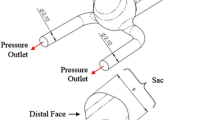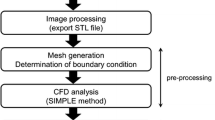Abstract
The deposition of intralumenal thrombus in intracranial aneurysms adds a risk of thrombo-embolism over and above that posed by mass effect and rupture. In addition to biochemical factors, hemodynamic factors that are governed by lumenal geometry and blood flow rates likely play an important role in the thrombus formation and deposition process. In this study, patient-specific computational fluid dynamics (CFD) models of blood flow were constructed from MRA data for three patients who had fusiform basilar aneurysms that were thrombus free and then proceeded to develop intralumenal thrombus. In order to determine whether features of the flow fields could suggest which regions had an elevated potential for thrombus deposition, the flow was modeled in the baseline, thrombus-free geometries. Pulsatile flow simulations were carried out using patient-specific inlet flow conditions measured with MR velocimetry. Newtonian and non-Newtonian blood behavior was considered. A strong similarity was found between the intra-aneurysmal regions with CFD-predicted slow, recirculating flows and the regions of thrombus deposition observed in vivo in the follow-up MR studies. In two cases with larger aneurysms, the agreement between the low velocity zones and clotted-off regions improved when non-Newtonian blood behavior was taken into account. A similarity was also found between the calculated low shear stress regions and the regions that were later observed to clot.










Similar content being viewed by others
References
Burleson A., C. Strother, V. Turitto 1995 Computer modeling of intracranial saccular and lateral aneurysms for the study of their hemodynamics. Neurosurgery 37(4), 774–784, doi:10.1097/00006123-199510000-00023
Castro M. A., C. M. Putman, J. R. Cebral 2006 Computational fluid dynamics modeling of intracranial aneurysms: effects of parent artery segmentation on intra-aneurysmal hemodynamics. AJNR Am. J. Neuroradiol. 27, 1703–1709
Cebral J. R., M. A. Castro, S. Appanaboyina, et al. 2005 Efficient pipeline for image-based patient-specific analysis of cerebral aneurysm hemodynamics: technique and sensitivity. IEEE Trans. Med. Imaging 24(4), 457–467, doi:10.1109/TMI.2005.844159
Chaturani P., R. P. Samy 1985 A study of non-Newtonian aspects of blood flow through stenosed arteries and its applications in arterial diseases. Biorheology 22, 521–531
Choi H. W., A. I. Barakat 2005 Numerical study of the impact of non-Newtonian blood behavior on flow over a two-dimensional backward facing step. Biorheology 42, 493–509
Hassan T., M. Ezura, E. V. Timofeev, et al. 2004 Computational simulation of therapeutic parent artery occlusion to treat giant vertebrobasilar aneurysm. AJNR Am. J. Neuroradiol. 25, 63–68
Humphrey J. D., S. Na 2002 Elastodynamics and arterial wall stress. Ann. Biomed. Eng. 30, 509–523, doi:10.1114/1.1467676
Imbesi S. G., C. W. Kerber 2001 Analysis of slipstream flow in a wide-necked basilar artery aneurysm: evaluation of potential treatment regimes. AJNR Am. J. Neuroadiol. 22, 721–724
Johnston B. M., P. R. Johnston, S. Corney, D. Kilpatrick 2006 Non-Newtonian blood flow in human right coronary arteries: transient simulations. J. Biomech. 39, 1116–1128, doi:10.1016/j.jbiomech.2005.01.034
Jou L. D., G. Wong, B. Disensa, et al. 2005 Correlation between lumenal geometry changes and hemodynamics in fusiform intracranial aneurysms. AJNR Am. J. Neuroradiol. 26, 2357–2363
Kerber C. W., S. T. Hecht, K. Knox, et al. 1996 Flow dynamics in a fatal aneurysm of the basilar artery. AJNR Am. J. Neuroradiol. 17, 1417–1421
Kim, S. A study of non-Newtonian viscosity and yield stress of blood in a scanning capillary-tube rheometer. Drexel University, 2002
Liepsch D. W. Effect of flood flow parameters on flow patterns at arterial bifurcations studies in models. In Liepsch D. W., ed. Blood Flow in Large Arteries: Applications to Atherogenesis and Clinical Medicine. Monographs on Atherosclerosis, Vol. 15. Basel: Karger, 1990. pp. 63–76
Long Q., X. Y. Xu, B. Ariff, et al. 2000 Reconstruction of blood flow patterns in a human carotid bifurcation: a combined CFD and MRI study. J. Magn. Reson. Imaging 11, 299–311, doi:10.1002/(SICI)1522-2586(200003)11:3<299::AID-JMRI9>3.0.CO;2-M
Long Q., X. Y. Xu, M. Bourne, T. M. Griffith 2000 Numerical study of blood flow in an anatomically realistic aorto-iliac bifurcation generated from MRI data. Magn. Reson. Med. 43, 565–576, doi:10.1002/(SICI)1522-2594(200004)43:4<565::AID-MRM11>3.0.CO;2-L
Long Q., X. Y. Xu, M. W. Collins, et al. 1998 The combination of magnetic resonance angiography and computational fluid dynamics: a critical review. Crit. Rev. Biomed. Eng. 26, 227–274
Low M., K. Perktold, R. Raunig 1993 Hemodynamics in rigid and distensible saccular aneurysms: a numerical study of pulsatile flow characteristics. Biorheology 30, 287–298
Mantha A., C. Karmonik, G. Benndorf, et al. 2006 Hemodynamics in a cerebral artery before and after the formation of an aneurysm. AJNR Am. J. Neuroradiol. 27, 1113–1118
Perktold K., R. Peter, M. Resch 1989 Pulsatile non-Newtonian blood flow simulation through a bifurcation with an aneurysm. Biorheology 26, 1011–1030
Rayz, V. L., L. Boussel, G. Acevedo-Bolton, et al. Numerical simulations of flow in cerebral aneurysms: comparison of CFD results and in vivo MRI measurements. J. Biomech. Eng. 130, 2008. doi:10.1115/1.2970056.
Rayz V. L., M. T. Lawton, A. J. Martin, et al. 2008 Numerical simulation of pre- and post-surgical flow in a giant basilar aneurysm. J. Biomech. Eng. 130, 021004, doi:10.1115/1.2898833
Steiger H., A. Poll, D. Liepsch, H. Reulen 1987 Basic flow structure in saccular aneurysms: a flow visualization study. Heart Vessels 3, 55–65. doi:10.1007/BF02058520
Steiger H. J., A. Poll, D. Liepsch, H. J. Reulen 1987 Hemodynamic stress in lateral saccular aneurysms. Acta Neurochir (Wien) 86, 98–105, doi:10.1007/BF01402292
Steinman D. A. 2002 Image-based computational fluid dynamics modeling in realistic arterial geometries. Ann. Biomed. Eng. 30, 483–497. doi:10.1114/1.1467679
Steinman D. A., J. S. Milner, C. J. Norley, et al. 2003 Image-based computational simulation of flow dynamics in a giant intracranial aneurysm. AJNR Am. J. Neuroadiol. 24, 559–566
Stroud J. S., S. A. Berger, D. Saloner 2002 Numerical analysis of flow through a severely stenotic carotid artery bifurcation. J. Biomech. Eng. 124, 9–20, doi:10.1115/1.1427042
Tateshima S., Y. Murayama, J. P. Villablanca, et al. 2001 Intraaneurysmal flow dynamics study featuring an acrylic aneurysm model manufactured using a computerized tomography angiogram as a mold. J. Neurosurg. 95, 1020–1027
Tateshima S., K. Tanishita, H. Omura, et al. 2007 Intra-aneurysmal hemodynamics during the growth of an unruptured aneurysm: in vitro study using longitudinal CT angiogram database. AJNR Am. J. Neuroradiol. 28(4), 622–627
Taylor C. A., M. T. Draney, J. P. Ku, et al. 1999 Predictive medicine: computational techniques in therapeutic decision-making. Comput. Aided Surg. 4, 231–247
Tu C., M. Deville 1996 Pulsatile flow of non-Newtonian fluids through arterial stenosis. J. Biomech. 29, 899–908, doi:10.1016/0021-9290(95)00151-4
Valencia A. A., A. M. Guzmán, E. A. Finol, C. H. Amon 2006 Blood flow dynamics in saccular aneurysm models of the basilar artery. J. Biomech. Eng. 128, 516–526. doi:10.1115/1.2205377
Valencia A., A. Zarate, M. Galvez, L. Badilla 2006 Non-Newtonian blood flow dynamics in a right internal carotid artery with a saccular aneurysm. Int. J. Numer. Methods Fluids 50, 751–764, doi:10.1002/fld.1078
Wang K. C., R. W. Dutton, C. A. Taylor 1999 Improving geometric model construction for blood flow modeling. IEEE Eng. Med. Biol. Mag. 18, 33–39. doi:10.1109/51.805142
Zhao S. Z., X. Y. Xu, A. D. Hughes, et al. 2000 Blood flow and vessel mechanics in a physiologically realistic model of a human carotid arterial bifurcation. J. Biomech. 33, 975–984. doi:10.1016/S0021-9290(00)00043-9
Author information
Authors and Affiliations
Corresponding author
Rights and permissions
About this article
Cite this article
Rayz, V., Boussel, L., Lawton, M. et al. Numerical Modeling of the Flow in Intracranial Aneurysms: Prediction of Regions Prone to Thrombus Formation. Ann Biomed Eng 36, 1793–1804 (2008). https://doi.org/10.1007/s10439-008-9561-5
Received:
Accepted:
Published:
Issue Date:
DOI: https://doi.org/10.1007/s10439-008-9561-5




